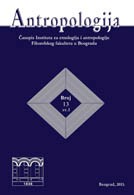FILOGENEZA I ONTOGENEZA IGARA – POSTOJI LI PARALELIZAM?
PHYLOGENESIS AND ONTOGENESIS OF GAMES IS THERE A
PARALLELISM?
Author(s): Joško SindikSubject(s): Cultural Anthropology / Ethnology, Sociology of Culture
Published by: Институт за етнологију и антропологију
Keywords: classification of classes and types of games; preschool children; differences;
Summary/Abstract: The article shows the classification of games according to the concept of Roger Caillois for type of games: agon, alea, mimicry, ilinx. Analogously to Caillois' "phylogenetic" view about entire dominance of certain types of games, is derived hypotheses about potential ontogenetic sequence of the frequency representation of different games according to chronological age. The classes of games are differentiated, depending on the extent of the meaning that has the word "game" in each definition. It is assumed that at the games in the strict sense of the word, chronologically the first occurr in children ilinx and mimicry and later agon and alea. At the institutional form of games is also assumed that games type ilinx and mimicry occur before games agon and alea, as a function of age, while mimicry occur before ilinx games. In games without frontiers is usually first appear ilinx, then mimicry, after it agon and alea as last type of the game. At perverse games, mimicry occurs the first (hypothetical), then agon and alea games, while the latter are games type ilinx. Games by Bern and entertainment does not make sense to observe ontogenetic, at least in early age child. The empirical research was to investigate the sequence of occurrence of games in the strict sense of the word in different age groups of preschool children. A sample of preschool children of different ages was examined in the kindergarten Sleeping Beauty in Zagreb. Between the first and second phase of the assessment were systematically encouraged hypothetical "progressive" types of games. It was found that "typical" games, which are probably the dominant in preschool age are of mimicry types, especially in spontaneous activity. During the research, there was an increase in the representation of hypothetical "advanced" types of games, which can indicate the desirability of planned stimulating "complex" types of games for children, in order to encourage the overall development of the child.
Journal: Antropologija
- Issue Year: 13/2013
- Issue No: 1
- Page Range: 61-92
- Page Count: 32
- Language: Croatian

